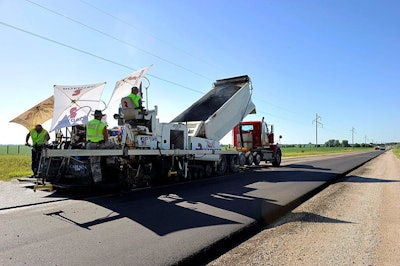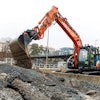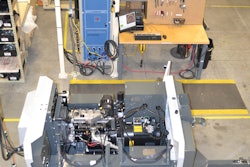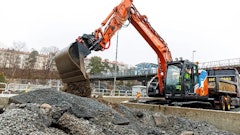
Technology is invading the jobsite at every angle today and for good reason. Going paperless can improve business operations and decrease the amount of resources needed to get the job done. In the highway construction industry, electronic lettings have been standard operating procedure for the Iowa Department of Transportation (DOT) for many years. Recently, the agency partnered with a contractor and a software provider to bring the e-construction process right to the point where the asphalt truck arrives at the jobsite to unload.
Working with Manatts Construction Co., Greg Mulder, P.E., director of the Iowa DOT's office of construction and materials, and his staff recently piloted a "proof of concept" project and developed what they think could be the next step in a paperless, efficient process for documenting asphalt deliveries to highway construction projects.
For Mulder, extending the e-construction process to the point of asphalt delivery was a matter of safety, efficiency and best use of personnel.
"At the point of delivery is where we would hit a snag in the electronic process," he says. "Each truck driver still carries a paper load-out ticket used to document the details of the delivery that is collected by the Iowa DOT inspector on the jobsite."
For the Iowa DOT, there was a large amount of paper being generated for weight tickets that were needed to satisfy federal requirements for proof of delivery and quality assurance. Tickets can be lost and since tickets are required for contractor payment, tracking down lost tickets is a real time draw and brought questions forward about did that load actually get delivered to the job. Safety issues also exist with personnel climbing on the side of trucks to gather the weight ticket from the driver. Having GPS tracking of each truck ticket, makes this process very transparent.
For the pilot, Mulder chose a centrally located project to ensure oversight. Manatts was awarded the contract and was willing to partner with the Iowa DOT. After reviewing several similar software solutions and meeting Earthwave at an asphalt paving conference, Mulder realized that the company's Fleetwatcher software was very close to meeting his needs.
"The technology existed and with a few software tweaks, we could dramatically increase worksite safety and reduce tedious tasks of collecting tickets and be able to better use our trained and qualified people to work on quality control and project administration - items that will ultimately build better quality roadways."
Highway 69 pilot project
Highway 69 is a primary two-lane roadway that vertically dissects Iowa in two. The 8-mile-long resurfacing pilot project on Highway 69 was just south of Ames, which is in the central part of Iowa. Manatts was chosen to mill off the existing asphalt surface, rubbelize the concrete underneath, then place a new 7-in. asphalt overlay on top.
The project was actually completed in two phases, says Steve Rooney, general superintendent of Manatts Ames Division. The first phase in May 2015 was a mile-long stretch and completed in 10 days - no telematics were used during this portion of the project.
Manatts began using the Fleetwatcher technology from Earthwave on its equipment during the second phase, which started at the end of July 2015. During this 30-day phase, nearly 63,000 tons of asphalt were placed.
Using a global positioning system (GPS), Fleetwatcher not only tracks the location of trucks through GPS but displays important details regarding load cycle times at the plant, on the job and travel times between.
GPS transponders were installed in both company-owned and third-party trucks Manatts was using to haul hot mix asphalt (HMA) to the jobsite. GPS transponders were also installed on two pavers being used on the job. Installation was accomplished in the trucks via a cigarette lighter adapter in the cab, while the pavers' transponders were hardwired into their batteries. Both systems have an internal battery backup. The piloted system also included a mobile field application for smart phones and tablets.
These GPS transponders sent data back at several points in the process where geozones had been established. Geozones are essentially pins placed on a digital map that, when a transponder enters the specified area, will send notifications to document where the equipment is. During the pilot project, there were several geozones:
- A static geozone was setup around the HMA plant site
- A tighter sub-geozone was established around the scale to zero in on load-out times
- A static geozone was set up around the project's perimeter
- A mobile geozone with a 20-foot radius was placed around the pavers
Contractor benefits
Fleetwatcher recorded the truck's location during the entire cycle with time-stamped data when entering the scale, leaving the plant, entering the project, backing up to the paver and finally leaving the project and returning to the plant.
The telematics system also updated and recorded an electronic trail every minute throughout the day with real-time dashboards and graphical reports to help the Iowa DOT verify that the certified product was delivered and incorporated into the project.
While there are side benefits to DOTs, these reports and dashboards benefit contractors in many ways, says Larry Baker, vice president with Earthwave Technologies.
"Contractors can easily visit a website and setup a project using a map with boundaries," he says. "They can track truck movements using a dashboard and generate reports. Data can be exported to a spreadsheet file for further analysis. The primary benefit is the reduction in large amounts of paper and quick analysis."
Contractors need not worry about dead zones, says Baker. "Satellites triangulate the location and the Verizon network is used for communication," he says. "The system stores all packets received, so if there is a dead zone, the system catches up with coverage is back."
Baker says this type of system also has the ability to enhance the contractor/subcontractor relationship. "If a contractor is paying by time increment instead of quantity, it could alleviate any issues with full payment for downtime, such as refueling time," he says. "By using this e-construction tool, the benefits of reducing one truck per day or a 10-hour shift can save as much as $1,000 a day."
In the pilot project, the plant needed consistent internet service, but the paver did not need a connection at all times. "If a device can access the internet, it can be incorporated into the system," says Baker.
Rooney with Manatts said the greatest benefit he saw during the Highway 69 project was the ability to track trucks through the system and average cycle times quickly. "We were able to make sure trucks are where they're supposed to be," he says. "We were also able to determine if there were too many or too few trucks."
He said one downside to using the technology was needing someone at the plant to ensure third-party trucks had the transponders installed. "Installation was very simple in the trucks, just plug and go," he says. "But I had to spend 20 to 30 minutes each morning to make sure each truck was outfitted with the technology."
Rooney said he liked that contractors could streamline reports and share select information with the DOT. "We could generate a report and share the information the DOT wanted with them electronically," he explains. Some information that exists in the system is oriented toward driver behavior and equipment usage, that is useful for the contractor was not selected to be shared in the DOT report.
The future of e-construction in Iowa
Mulder and Rooney felt the Highway 69 e-construction pilot project was a success.
"To be completely successful with a paperless ticketing system, scale integration is needed with the Fleetwatcher system," says Mulder. "Scale integration would allow for electronic verification of the product and tonnage to be included with the product location verification tool."
Mulder says the Iowa DOT is planning to conduct additional pilot projects in 2016 that combine the electronic location data and reports from the initial pilot project with a new data element, electronic ticketing. Earthwave is currently working on and successfully testing an integration of electronic scales report-out systems with the GPS tracking reports to give contractors a daily summary report of the tonnage and certified materials types along with the GPS tracking as a part of their materials delivery solution.
"If everything goes as planned, our inspectors will be able to see when a truck is on the way with a mobile app in the field and be able to access electronic ticket numbers with the tonnage and certified material type electronically captured," he says. "The inspector should be able to integrate that data into daily reports without having to collect each ticket manually or key into a contractor pay software."
Mulder says electronic ticketing can have a major impact on the safety and efficiency at a jobsite. And while there's a long way to go to see paperless load tickets at every jobsite, he says this year's pilot projects can answer a lot of outstanding questions about how electronic ticketing will work.
"We still need to work out the audit process, and for the next pilot project, each driver will still carry a paper ticket for verification purposes," he says. "But we're looking forward to exploring electronic ticketing with scales integration to bring the next logical step in the e-construction process to fruition. If these next pilot projects are successful, we'll likely start including paperless ticketing as a contract requirement in the near future."

















